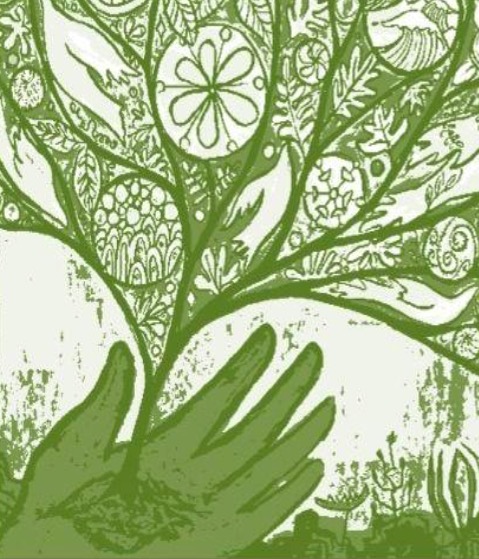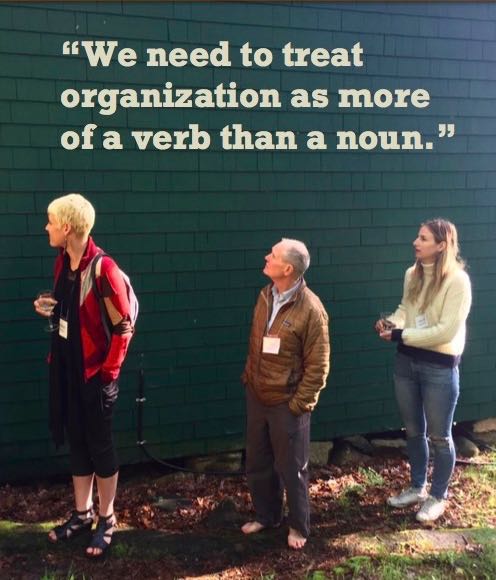-

A few months ago, we convened a 3-day gathering, in partnership with The McConnell Foundation, to explore how to spread the practice of Expressive Change across Canada. It was both an affirming and challenging experience, one that we’re still feeling the ripples from.
The intention to spark a community of practice in Canada has been percolating for many years. We chose to convene this gathering now because it feels like the time is ripe. A critical mass of people have come to realize that the status quo of organizational life is unsustainable. The notion that we have to transform our organizations if we are going to transform the world is moving from the margins to the mainstream.
The following key reflections emerged from the gathering around what expressive change looks like in practice and how we can help to spread it:
.
-1- Working at the level of the social field
Participants affirmed the importance of working at the deepest level of organizational life- ‘the social field’. The social field is different from organizational culture, structure, and leadership. It is the overall experienced quality of relationship in a given human system, the soil out of which all else grows. If we want to do truly transformative work, we must cultivate a transformative experience of relationships within and between organizations.
.
-2- Scaling questions not solutions
Because expressive change is a way of being, rather than a way of doing, and highly contextual, it does not easily translate into a set of scalable practices. The best way to spread it is through contagious inquiry. This means seeding provocative questions that trigger people to reflect on and experiment with the inner life of their organizations. Questions like:

– What kind of organizational experience is required for us to create deep system transformation?
– How do we move from being ‘in service to others’ to being ‘in service to each other’?
– How do we transform our interactions with our colleagues from feeling transactional to feeling relational?
– How do we move from approaching our social change work linearly and mechanically to emergently and holistically?
In addition to overarching questions like these, it would also help to develop context-sensitive paths of inquiry that speak to different organizational spaces, functions, roles, and lifecycle stages. For example: How is expressive organizing different in an environmental organization than in a human rights organization? How does it play out differently in a start-up, compared to a well-established organization? An inquiry-based approach to scale helps us to avoid sliding into a judgmental ‘walk the talk’ mindset.
.
-3- Experientially shifting patterns of oppression
Expressive organizing develops our capacity to work at the deepest layers of oppressive systems. Too often our attempts to dismantle colonial, economic, and patriarchal systems only scratch the surface because we tackle them ideologically and structurally. Expressive organizing involves engaging with them at the experiential level, in the day-to-day of our work together. This involves:
– Exploring how trauma, power, and privilege play out in our working relationships and experimenting with more life-giving ways of relating. As one participant shared, “We need to focus on a healthy call-in culture over a shaming call-out culture.”
– Listening to anger with a non-defensive ear, recognizing that it is often a reflection of larger generational cycles of collective pain and oppression.
– Speaking truth to power with equal doses of fierceness and kindness, provocation and support. This dual approach is critical if we want to make more headway in cracking open the hard shell of privilege. It involves recognizing that many people doing social change work, including those with privilege, are coming from places of personal pain.
– Unpacking what ‘systemic change’ means to different people and organizations. Too often we assume we mean the same thing, but in reality our understandings can be quite different.
.
-4- Sparking widespread experimentation

Excerpt from a poem by gathering participant Nadia Duguay We need to inspire organizations of all types to experiment with expressive change in their contexts. And we need this experimentation to be widely distributed within organizations. We cannot rely on positional leaders and hired consultants. Organizational hacking needs to be something that everyone, at every level of an organization, feels emboldened to do. This means encouraging experiments that are:
– Light on resources and time and integrated into the normal flow of every-day work.
– Related to any aspect of organizational life: Mission/ vision/values development, division of work tasks, scheduling & workflow, leadership, teamwork, fundraising, budgets, concepts of efficiency & effectiveness, and even organizational death. Nothing should be off-limits.
– Focused on the periphery of organizational life, where there is less resistance to change and more room to play.
.
-5- Norming the conversation
The simplest way of seeding expressive change more broadly is to talk about it. The more we talk about it, the more legitimacy it holds. However to spread the conversation well, we need to develop simple, sticky language. For example, the term ‘inscaping’ (referring to the practice of surfacing the inner experience of an organization) has proven to be a sticky word in a variety of contexts, including this gathering.
We also need a framework to communicate the nuances of expressive change in an easy-to-digest way. It would include stories of practice, hands-on materials to spark conversations and experiments (ex. “5 questions a skeptical board is going to ask”), readings, and audio-visual resources. It would also need to make a compelling case for why expressive change is important. For example:
The missing middle – There is an increasing recognition of the importance of practicing individual mindfulness in social change work. At the same time, there is a growing focus on approaching social issues with a systems lens. These two perspectives are critical, but they are incomplete without the missing middle- organizational transformation. We need to simultaneously work at the individual, organizational and systems level.
Climate resilience – Given the unfathomable disruption facing our species, we cannot afford to lose so many activists to burnout. An overheated social change sector cannot work to heal an overheated planet. We cannot work unsustainably to shift to a more sustainable world. And if we are indeed approaching the end of the world as we know it: How do we want to show up at the end? How do we want to live as we die?
.
-6- Learning how to organize from nature
Nature was a constant learning companion during the gathering. It gave us insight into the ‘how’ of expressive organizing, reminding us of the value of interconnectedness and reciprocity. It also brought a more organic perspective to our thinking about how to spread expressive change. We took lessons from shoots, seeds, spores, pods, pollination, roots, carriers, bulbs, polyps, grafting, landslides, fire, and lichen. How can nature continue to play a supporting role in our efforts going forward? How does nature learn, grow and change? What are its core relational patterns? How does it engage with conflict?
.
-7- Expanding our definition of organization

When looking to diffuse expressive change, it is important to focus on conventional organizations because that is where most social change work is still taking place. However, we also need to expand our definition of organization. In the words of one participant, “We need to treat organization as more of a verb than a noun.” This means seeking out informal spaces of learning, organizing, community-building, and philanthropy. A lot can be gained from sharing the organizational experiments happening in informal spaces with more formal organizations.
We also need to pay more attention to the spaces between organizations. For example, one participant, who works for a foundation, described her relationship with grantees as a type of organization: “I’m not in their organization and they’re not in mine. We are in organization together.” A more expansive definition of organization that was shared was “people together on purpose.”
.
-8- Prioritizing attention over intention
Working at the level of the social field requires that we turn our organizing paradigm on its head and start from a place of attention rather than intention. This means:
– Putting more focus on our collective state of being, rather than on planning and action.
– Developing the capacity to sense the broader social system as it moves through our organization.
– Bringing an appreciative lens to discover the hidden gifts and resources that already exist within and around us.
– Moving beyond good intentions and towards relationships that breed radical honesty, trust, humility, mutual accountability, and growth.
– Using art-based practices to tap into different ways of seeing.
Only by cultivating these kinds of organizational sensing capacities will we be able to truly engage with our blind spots and shift our destructive patterns of thought and action. Intention still has its place; but it must grow out of attention so that it becomes more self-aware and responsive.
.
-9- Learning from Indigenous organizational practices
In many Indigenous traditions a great deal of attention is put on how we come together to organize. There is a deep understanding, from centuries of practice, of how to build community and connection through work. Several participants expressed a desire to draw on Indigenous perspectives, and one of the Indigenous participants mentioned that she was keen to share experiences from her organization. However, because there was not a strong Indigenous presence at the gathering, we did not end up exploring this in much depth. It is an important area of focus to incorporate into future endeavors.
.
-10- Seeding expressive change expressively

It is important that the communities of practice, support organisations, and reflection spaces are themselves working to be expressive. This gathering was a good example of this. Participants spoke of how refreshing it was to get to know each other first as human beings, rather than as representatives of their organizations, and to organically connect around topics they were truly passionate about. They also commented on how that fed their engagement: “We dove really deep, really fast as a group because of how we organized together.” “We were doing the ‘how’ which allowed us to articulate what the ‘how’ was.”
At the same time, it is impossible to practice expressive change perfectly. For example, one of the participants observed that there were many missed opportunities for learning because we didn’t take time to fully dive into moments of conflict and high emotion. Another participant expressed concern that we ended up mirroring some of the unhealthy patterns of work/life imbalance that are so rampant in the sector at-large. Such challenges, when approached with a learning stance, can provide valuable insight into how to deepen the practice expressive change.
.
Hotspots for diffusion
In addition to exploring the themes above, we also spent time thinking strategically about how to spread expressive change across Canada. We asked ourselves: Where is expressive change already happening or being talked about? What parts of the system are ripe for it to take root? Where are there blocks that are ready to be released?
As we explored these questions, nine hotspots emerged. You can read about them here in the full write-up of the gathering.
.
.
Seeding Expressive Change across Canada




Comments are closed.